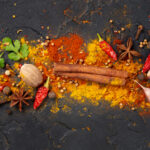
THE INTERTWINED MEDLEY OF INDIAN TASTE
India is a diverse country with multifaceted cultures, languages, and cuisines. There is a widespread saying that the culture of India alters every 10 miles and, with it, modifies the taste buds. Indian cuisines are a multitude of bursts of flavourful emotions, which is an attestation of their respective customs and
cultures.
India is an extensive myriad of contrasting communities, triggered by the variegated smack of ancient flavours that would exude dopamine even in the dullest of minds.
The country of India is so affluent in diversity that it can itself be considered a continent. We bifurcate European cuisines as French cuisine, Italian cuisine, and German cuisine, but the multifariousness of Indian cuisine is highly stereotyped and oversimplified. The food concept in India changes when one commutes from one state to another due to the alteration in culture.
Also, there is a misconception that Indian food is ladened with spices and that India is the birthplace of spices. Well, this is flawed, as red chillies were introduced in India by the Portuguese around 450 years ago. Although yes, the lush green fields of Andhra Pradesh, Karnataka, Rajasthan, Tamil Nadu, Kerala, and more produce tons of spices for local as well as international use.
An amalgamation of the multitude of Indian traditional identities has painted the Indian culture as an exquisite mosaic that, in turn, has relished us with diversified savory flavours.
Kashmiri saffron, Kashmiri red chilli, Kashmiri cumin, ver, and dried cockscomb flower are the most widely used spices in Kashmiri cuisine.
Punjabi cuisine is famous for its rich flush of flavours swarmed with spices like turmeric, cumin, cinnamon, fennel, nutmeg, cardamom, saffron, coriander, fenugreek, and many more customized blends of zest.
In Uttarakhand, the food is simple yet appealing. Apart from the common spices, there are specialized spices included in the diet that are remote to their land, like jakhiya, baby onion leaf, gandrain, Badri tulsi, etc.
Gujarati cuisine is a blend of sweet and tangy with a wee bit of spice. The most common spices used are turmeric, red chilli, mustard seeds, kokum, and sesame seeds.
Maharashtrian cuisine is a flavourful combo ranging from mild to extremely spicy, inculcating various tastes. Sesame seeds, kokum, tamarind, and black stone flower are employed extensively, apart from the common spices.
Rajasthani cuisine has a tangy and richly spicy flavour, employing a rich blend of spices in its food.
South India is divided into five states, namely Andhra Pradesh, Tamil Nadu, Kerala, Karnataka, and Telangana. All these regions have a rich flavour for taste buds, but one thing remains constant: the dosage of chilli and pepper is higher compared to other regions.
On the other hand, the North East, sandwiched between Myanmar and Bangladesh, with a tinge of Chinese influence, has simpler, milder-tasting cuisines. They resist making use of many spices and like to keep their meals enriched with natural flavours.
The king of blends in India, Garam Masala, has its own customized flavours based on the regions where it is consumed. The flavour, aroma, and ingredients of garam masala differ in every region.
There is also a unique blend of cuisines from Bengal, Bihar, Uttar Pradesh, Haryana, Odisha, Madhya Pradesh, Chhattisgarh, and Jharkhand, with each offering a different portrait of flavours.
So, India is not just a country but a country with the essence of a rich array of intangible thrusts of diversity in all aspects. Therefore, baking India with the assumption of being a straight single monolith of spices is not a justification for its massive variety of kitchen laboratories and rich grandma-nuska paradise.
Recent Posts
rkigroup24
THE INTERTWINED MEDLEY OF INDIAN TASTE
rkigroup24
THE EXHILARATING MASALA DABBA
+0123 (456) 7899
contact@example.com



